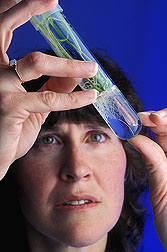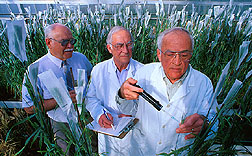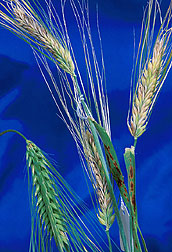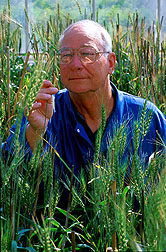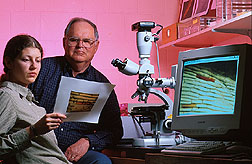Fighting Fusarium
Almost every year, a disease called head scab wreaks havoc somewhere in America.
Scab now ranks as the worst plant disease to hit the United States since the stem rust of the 1950s. In the past decade, outbreaks in Illinois, Indiana, Michigan, Minnesota, North Dakota, Ohio, and South Dakota have led to more than $1 billion in crop losses.
|
|
Caused by a fungus known as Fusarium graminearum, scab gets its name from the whitish-gray lesions that form on the kernel-bearing portion, or head, of infected wheat or barley plants. The Fusarium microbe can also cause root, stalk, and ear rots in corn.
Infected wheat kernels often shrivel and become discolored, and they may harbor compounds called mycotoxins that are manufactured by the fungus. Most notable of these natural compounds is deoxynivalenol, which can make wheat unsuitable for flour or cereals and too toxic for sale as animal feed.
Today, Agricultural Research Service scientists at a half-dozen laboratories around the United States are exploring an array of tactics to thwart the fungus.
Deactivating the Toxin
One defensive strategy relies on exploiting the mechanism apparently used by F. sporotrichioides, a relative of F. graminearum, to protect itself from its own toxin, known as T-2.
"Because both of these Fusarium species produce toxins the same way," explains ARS microbiologist Nancy J. Alexander, "the process they use to deactivate those toxins may also be similar."
Alexander and colleagues with ARS at Peoria, Illinois, found—in F. sporotrichioides—a T-2 resistance gene that they named TRI-R.
"This gene," says Alexander, "cues the fungus to make an enzyme that alters the structure of the toxin. The enzyme does this by placing a protective chemical group on the toxin. The altered toxin apparently can't harm the fungus."
"Equipping wheat and barley plants with a gene to deactivate the toxin made by the scab fungus, F. graminearum, might give the plants a new and powerful form of protection."
Expelling the Toxin
Another organism in nature—the Saccharomyces cerevisiae yeast used in breadmaking—has a gene called PDR5 that can pump toxins out of its cells. Alexander and co-researchers borrowed PDR5 from scientists at The Catholic University of America in Washington, D.C. They rebuilt it to work in plants.
Now, ARS colleagues in Fargo, North Dakota, are moving PDR5 and TRI-R into barley, while co-workers in Albany, California, are transferring the genes into wheat.
ARS geneticist Lynn S. Dahleen at Fargo has some healthy plants with the TRI-R gene working inside and others that boast the PDR5 gene. "Now our goal," says Dahleen, "is to get both genes up and running in the same barley plant—preferably one that's either a commercial variety or at least similar to a commercial barley."
One target of Dahleen's experiments: MNBrite, a commercial barley from the University of Minnesota. The North Dakota Barley Council is financing some of this work.
A handful of wheat plants nurtured in an Albany lab and greenhouse are also now outfitted with either the PDR5 or TRI-R gene. Ann E. Blechl and Patricia A. Okubara at Albany used a gene gun, or bioblaster, to propel gold particles coated with these genes into wheat cells. Fusarium-resistance testing will follow. The North American Millers Association is funding part of this research. Proteins To Knock Fusarium Out
Blechl and Okubara are also examining wheat genes that may knock out the pathogen.
In tests elsewhere, proteins produced on command by these genes hindered still another F. graminearum relative, F. oxysporum. A scientist at the University of Zurich provided one of these experimental genes. It tells plants to make what's known as a thaumatin-like protein. A second gene, isolated by Kent F. McCue at the Albany center, directs plants to produce a protein called purothionin.
Another protein in the thionin family—hordothionin—is a target of research by ARS scientists and their colleagues in Madison, Wisconsin.
ARS molecular biologist Ronald W. Skadsen says, "We think hordothionin and another protein, permatin, may play a role in keeping Fusarium from gaining a foothold in barley kernels." Skadsen and colleagues cloned two genes that barley plants use to make the proteins.
"In barley," Skadsen says, "these proteins are found only inside the kernel. We're hoping to rebuild the genes so that plants will produce the proteins on leaflike structures that surround the kernel, where Fusarium can begin its attack."
The American Malting Barley Association and the North American Barley Genome Mapping Project help fund the research. Help From a Wild Relative
|
|
A wheat cousin called wild emmer has resistance genes that might be moved into domesticated wheat. Emmer is a relative of durum wheat, which is used to make flour for pasta and for pizza doughs.
North Dakota State University researchers, along with ARS plant pathologist James D. Miller and ARS geneticists Leonard R. Joppa and Norman D. Williams at Fargo, are crossing emmer with domesticated durum wheats. The work gets some support from grants from the Agricultural Production and Utilization Committee of North Dakota, North Dakota Wheat Commission, and U.S. Durum Growers Association.
In other experiments, they are crossing wild emmer with special wheats called aneuploids.
"Aneuploids are invaluable to us," says Williams, "because they take up individual emmer chromosomes intact. That makes it easier to find which emmer chromosome contains a resistance gene. Once we locate that chromosome, we may be able to pinpoint the location of the resistance gene on it—or at least that of an associated marker gene."
Markers Tell Us Where It's At
A marker gene is a sequence of DNA that acts somewhat like a signpost to indicate the presence of a gene of interest. "When we find wheat-emmer hybrids that have a resistance gene or marker," Williams says, "we can select the best of these plants for further breeding."
"The more scab-resistance markers scientists can identify," says geneticist James A. Anderson, "the closer we should all come to locating the actual resistance genes that we're seeking." Anderson, formerly with ARS at Pullman, Washington, and now with the University of Minnesota at St. Paul, is among the first to find a scab-resistance marker in wheat.
He did the work with researchers at North Dakota State University. The research was funded by a USDA National Research Initiative Grant, the North American Millers Association, and the North Dakota State University Research Foundation.
In all, the team discovered five markers. They crossed a scab-resistant wheat from China, called Sumai 3, with a moderately susceptible variety, called Stoa, from North Dakota. Then they examined the offspring.
|
|
"We chose a Chinese variety as one of the parents," says Anderson, "because some Chinese wheats appear to have the best natural resistance."
The researchers located markers for two genes that, Anderson says, "seem to have significant impact on scab resistance. The three other markers indicate genes that make minor contributions."
Other promising markers have been discovered by scientists with the University of Illinois at Urbana, working with ARS molecular biologists Guihua Bai—now at Peoria—and Leslie L. Domier at Urbana. They crossed Ning 7840, a scab-resistant Chinese wheat, with Clark, a susceptible variety developed in Indiana.
"One marker," says Bai, "is linked to a gene that may account for up to 50 percent of the scab resistance. Several other markers are for two minor genes that may account for another 20 percent of the resistance."
Further research may reveal other new markers linked to different resistance genes. "Resistance from different genetic sources," says Bai, "is the best option, because it will give breeders a larger pool from which to develop new varieties for the future."
Screening for Resistance
The best-performing plants from these and other experiments may make their way to the Uniform Regional Scab Nursery, a rigorous program of scab-resistance screening of new wheats for the upper Midwest. ARS plant geneticist Robert H. Busch, who is at St. Paul, coordinates the nursery, helping breeders field-test candidate wheats.
Previously, Busch helped oversee distribution of USDA funds for scab-resistance research at ARS labs and universities nationwide. This year those funds totaled $3.5 million.
In his own breeding research, Busch develops scab-tolerant wheats for the upper Midwest, including one he is releasing this year. "Through both conventional breeding and biotechnology," Busch says, "we expect to be able to offer high-yielding wheats with even more scab resistance in the future."
Some of the other new wheats and barleys for the upper Midwest might contain genes discovered or rebuilt by Busch's ARS colleagues at St. Paul. William R. Bushnell, for example, is developing a faster, less expensive test to determine if experimental scab-resistance genes can help cells foil Fusarium.
|
|
He links a gene he is testing for scab resistance to another gene that cues plants to make anthocyanin, a natural pigment that gives fall leaves their red colors. After the genes are shot into plant tissue, cells with the anthocyanin gene turn red. This means they have likely taken up the gene for possible scab resistance, as well.
When the tissue is inoculated with Fusarium and monitored under a microscope, the distinctive color makes it faster and easier to pinpoint these key cells.
Microbial Controls
In addition to giving plants new, more powerful genes to boost scab resistance, scientists are scrutinizing about 700 microbes for their potential to serve as biological controls of the fungus.
ARS plant pathologist David A. Schisler at Peoria and colleagues at Ohio State University are testing the microbes for their ability to gobble up two compounds naturally present on wheat heads when Fusarium strikes. The compounds are choline and betaine. They nourish the fungus as it grows from the male organs of wheat flowers—where it sometimes lands—to where it can infect the developing kernel deeper inside the flower.
Says Schisler, "We are also perfecting a liquid fermentation medium to economically produce the most effective microbes." The medium could be sprayed on wheat during flowering.
Other new tactics for outflanking the Fusarium fungi might come from sleuthing the microbe's development. To stalk the fungus, former Peoria microbiologist Thomas M. Hohn borrowed a gene from a bioluminescent jellyfish, Aequorea victoria, and hooked it to the fungus.
The jellyfish gene causes the fungus to glow a telltale green when fungal-infected tissues are exposed to fluorescent light. Though the idea of using the jellyfish gene in lab experiments isn't new, Hohn was apparently the first to use it for spying on Fusarium.
"This innovative pairing of jellyfish and Fusarium," says molecular biologist Skadsen, "should shed new light on the biology of this destructive fungus."—By Marcia Wood, Don Comis, Ben Hardin, Linda Cooke McGraw, and Kathryn Barry Stelljes, Agricultural Research Service Information Staff.
This research is part of Plant Diseases, an ARS National Program described on the World Wide Web at http://www.nps.ars.usda.gov/programs/cppvs.htm.
Contact scientists mentioned in this story through:
Marcia Wood, phone (510) 559-6070, fax (510) 559-5882.
Don Comis, phone (301) 504-1625, fax (301) 504-1641.
"Fighting Fusarium" was published in the June 1999 issue of Agricultural Research magazine.







